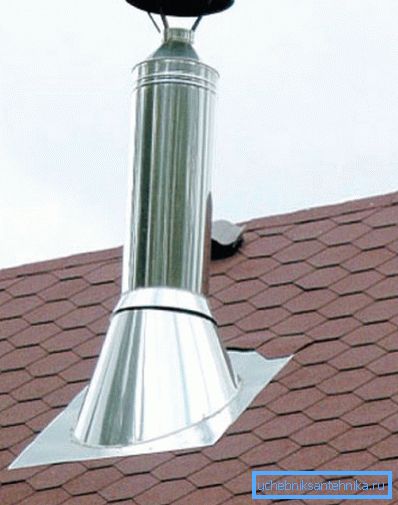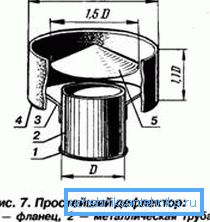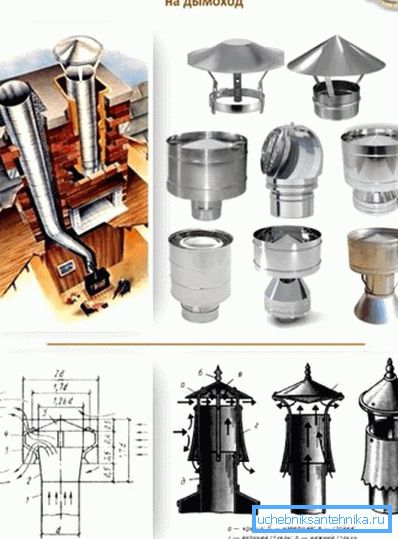The cap of the pipe will decorate and protect the chimney
If in the old days more attention was paid to the functionality of accessories during construction, today they also carry a decorative load. Often a pipe head on a house or cottage can surprise even the most sophisticated esthete. But still, the deflector (as the specialists call this element) is primarily obliged to protect the inside of the pipe.

Main functions
- Snow and rain, dust and leaves will constantly get inside if there is no cover on the pipe.
- The tip on the chimney pipe extinguishes flying sparks, preventing the likelihood of fire.
- Traction furnace, also markedly improved.
- Chimney cleaning with protection can be performed less frequently.
- Do not be surprised if in the pipe, not equipped with a cap, the bird decided to warm up will get stuck.
- With taste, the weathervane-cap will decorate and make even the most modest roof more respectable.
Classification by type of material

The durability of the "umbrella" above the pipe depends on the material from which it is made.
- Homemade chimney tip is usually made of tin - thin sheet metal. Not covered with a layer of zinc or paint, it quickly rusty. Therefore, using tin, paint the finished product with high-quality waterproof paint.
- Stainless steel is better suited for this purpose.. A well-made lid will last up to 27 years.

- Copper headings are popular. It is durable (from 50 years and more), oxidizing over time, acquires a spectacular noble shade. To extend the life of the cover should be mounted with copper or copper fasteners.
- The tips of the chimneys of zinc-titanium are similar in characteristics to copper.. They belong to the prestigious class and serve up to half a century.
Note! As a rule, the owner selects the supplement on the basis of budget possibilities. In many ways, the quality and category of accessories depends on the appearance of the house itself. For the middle class, galvanized steel tips are quite relevant.
External and structural characteristics
- The habitual for most of the cap is a cone-shaped round, resembling a hat of a Vietnamese peasant. It is easy to make and practical to use. But the imagination of citizens does not stand still, resulting in a mass of new forms.
- Slightly more difficult headings in the form of a house with two ramps. The option is practical, and the rating almost does not lag behind the round counterpart.
- Often there are hats caps, make such a do-it-yourself is extremely simple.
- Smoke hip more original, it looks good on the complex roofs.
- For those who like to decorate their “fortress”, there are a lot of offers with additions in the form of weather vanes, heraldic symbols, and images of animals. Forged products are quite expensive, but the beauty is worth it.
- To facilitate cleaning and periodic inspections, you can install an opening cover. In fact, the option is very convenient, now you do not have to dismantle the structure each time to remove soot.
- Analogs with a complicated hole for ventilation. Features of the design improve technical data, facilitate the exit of smoke and increase traction.
Note! If your stove is heated with wood, painted iron tips are extremely undesirable. The soot settles on them faster, and the color burns from the high temperature.
Independent manufacture of the chimney

Even for a homeowner with no skill in building affairs, it is not problematic to make and install a cap. Materials can be used at hand, leftovers from sheet steel will do.
Instruments
- Scissors for cutting metal.
- Several hammers of different shapes.
- Kiyanka
- Iron rods and corners.
- Waterproof enamel or varnish for outdoor use.
Note! For final painting, the instruction recommends a stove varnish or heat resistant paint. Then even soot and heat will not damage the finished structure.
The working process

- Be sure to make a sketch in full size. Of course, you need to know the diameter of the pipe in order to fit the cap to the size. It is not necessary to make the slopes much wider than the outlet or vice versa, the same size as it.
- Cut a pattern from cardboard or paper. So it is easier to transfer the contour to iron, and it is useful to see how the finished structure will look.
- The rounded cone is the easiest to make. It is necessary to cut a circle and make a narrow triangular incision in it with its apex toward the center.
- The resulting workpiece gently reduce to the state of an umbrella with uncoiled slopes.
- The seam is stamped, then fasten fasteners.
- After installation on the tube, the cap is painted in the desired color.
Making a pyramid-shaped deflector
The process is not more complicated than the previous one, the difference is that the production will require not a round, but a square piece of metal.
- Mark the center of the sheet and draw four lines to it from each corner.
- Slowly bend the sheet along each of the diagonals, while trimming each corner.
- You can mount the legs and mount the product on the chimney.
Installation of the finished tip

If you bought a professionally made deflector, it is very easy to attach it to the pipe yourself.
- Read the assembly and installation instructions. Usually the recommendations are extremely intelligible and standard equipment will be installed easily and quickly.
- Lay out all the details and try to figure out the assembly sequence. It all starts with the fixing of the lower cylinder on the protruding end of the chimney. Use fasteners in the form of an attached bolt-clamp.
- Then you can fasten the upper cylinder (diffuser).
- An umbrella is attached to the brackets to the upper cylinder.
- All connections are tested for strength and additionally tightened if necessary.
Conclusion
The full value of your heating equipment depends largely on the protection of the chimney. Even such a minor detail as an umbrella over the pipe can bring many benefits for a comfortable stay.
Our video in this article offers even more useful information.